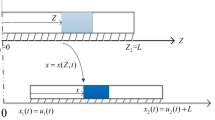Abstract
In this paper the author presents a mathematical model of a device that can be seen as a segment of an artificial worm (following the paradigm “earthworm”) and as an artificial muscle as well. Confining considerations to statics, the model shows up as an ordinary parameter-dependent boundary value problem. It is tackled numerically in various particular forms by means of Maple and thus gives a good view of the segment's behavior during inflation and under longitudinal load. Segments of maximal volume present a useful preliminary stage of the investigations.
Similar content being viewed by others
Author information
Authors and Affiliations
Corresponding author
Additional information
Thanks are to Klaus Zimmermann and his Motion Systems Group at TU Ilmenau for discussions and experiments, to Katrin Knabe for typing, and to an unknown reviewer for directing the author's attention to physical nonlinearity.
Rights and permissions
About this article
Cite this article
Steigenberger, J. Contribution to the mechanics of worm-like motion systems and artificial muscles. Biomechan Model Mechanobiol 2, 37–57 (2003). https://doi.org/10.1007/s10237-003-0027-2
Received:
Accepted:
Issue Date:
DOI: https://doi.org/10.1007/s10237-003-0027-2




